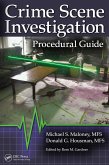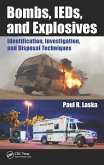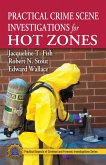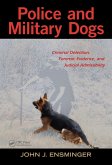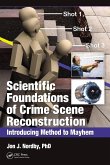Michael S. Maloney, Donald Housman, Ross M. Gardner
Crime Scene Investigation Procedural Guide (eBook, PDF)
61,95 €
61,95 €
inkl. MwSt.
Sofort per Download lieferbar

31 °P sammeln
61,95 €
Als Download kaufen

61,95 €
inkl. MwSt.
Sofort per Download lieferbar

31 °P sammeln
Jetzt verschenken
Alle Infos zum eBook verschenken
61,95 €
inkl. MwSt.
Sofort per Download lieferbar
Alle Infos zum eBook verschenken

31 °P sammeln
Michael S. Maloney, Donald Housman, Ross M. Gardner
Crime Scene Investigation Procedural Guide (eBook, PDF)
- Format: PDF
- Merkliste
- Auf die Merkliste
- Bewerten Bewerten
- Teilen
- Produkt teilen
- Produkterinnerung
- Produkterinnerung

Bitte loggen Sie sich zunächst in Ihr Kundenkonto ein oder registrieren Sie sich bei
bücher.de, um das eBook-Abo tolino select nutzen zu können.
Hier können Sie sich einloggen
Hier können Sie sich einloggen
Sie sind bereits eingeloggt. Klicken Sie auf 2. tolino select Abo, um fortzufahren.

Bitte loggen Sie sich zunächst in Ihr Kundenkonto ein oder registrieren Sie sich bei bücher.de, um das eBook-Abo tolino select nutzen zu können.
Those tasked with investigating crime scenes come from a variety of backgrounds and varying levels of experience. Crime Scene Investigation Procedural Guide gives the novice investigator the procedures for almost any crime scene imaginable while providing the seasoned pro a ready reference for crimes occurring even under the most unusual of circums
- Geräte: PC
- mit Kopierschutz
- eBook Hilfe
Andere Kunden interessierten sich auch für
![Crime Scene Investigation Procedural Guide (eBook, ePUB) Crime Scene Investigation Procedural Guide (eBook, ePUB)]() Michael S. MaloneyCrime Scene Investigation Procedural Guide (eBook, ePUB)61,95 €
Michael S. MaloneyCrime Scene Investigation Procedural Guide (eBook, ePUB)61,95 €![Bombs, IEDs, and Explosives (eBook, PDF) Bombs, IEDs, and Explosives (eBook, PDF)]() Paul R. LaskaBombs, IEDs, and Explosives (eBook, PDF)66,95 €
Paul R. LaskaBombs, IEDs, and Explosives (eBook, PDF)66,95 €![Practical Crime Scene Investigations for Hot Zones (eBook, PDF) Practical Crime Scene Investigations for Hot Zones (eBook, PDF)]() Jacqueline T. FishPractical Crime Scene Investigations for Hot Zones (eBook, PDF)142,95 €
Jacqueline T. FishPractical Crime Scene Investigations for Hot Zones (eBook, PDF)142,95 €![Police and Military Dogs (eBook, PDF) Police and Military Dogs (eBook, PDF)]() John EnsmingerPolice and Military Dogs (eBook, PDF)33,95 €
John EnsmingerPolice and Military Dogs (eBook, PDF)33,95 €![Illustrated Guide to Crlme Scene Investigation (eBook, PDF) Illustrated Guide to Crlme Scene Investigation (eBook, PDF)]() Nicholas PetracoIllustrated Guide to Crlme Scene Investigation (eBook, PDF)133,95 €
Nicholas PetracoIllustrated Guide to Crlme Scene Investigation (eBook, PDF)133,95 €![Scientific Foundations of Crime Scene Reconstruction (eBook, PDF) Scientific Foundations of Crime Scene Reconstruction (eBook, PDF)]() NordbyScientific Foundations of Crime Scene Reconstruction (eBook, PDF)70,95 €
NordbyScientific Foundations of Crime Scene Reconstruction (eBook, PDF)70,95 €![Forensic Intelligence (eBook, PDF) Forensic Intelligence (eBook, PDF)]() Robert MilneForensic Intelligence (eBook, PDF)53,95 €
Robert MilneForensic Intelligence (eBook, PDF)53,95 €-
-
-
Those tasked with investigating crime scenes come from a variety of backgrounds and varying levels of experience. Crime Scene Investigation Procedural Guide gives the novice investigator the procedures for almost any crime scene imaginable while providing the seasoned pro a ready reference for crimes occurring even under the most unusual of circums
Dieser Download kann aus rechtlichen Gründen nur mit Rechnungsadresse in A, B, BG, CY, CZ, D, DK, EW, E, FIN, F, GR, HR, H, IRL, I, LT, L, LR, M, NL, PL, P, R, S, SLO, SK ausgeliefert werden.
Produktdetails
- Produktdetails
- Verlag: Taylor & Francis eBooks
- Seitenzahl: 348
- Erscheinungstermin: 14. Mai 2014
- Englisch
- ISBN-13: 9781466557550
- Artikelnr.: 57105574
- Verlag: Taylor & Francis eBooks
- Seitenzahl: 348
- Erscheinungstermin: 14. Mai 2014
- Englisch
- ISBN-13: 9781466557550
- Artikelnr.: 57105574
- Herstellerkennzeichnung Die Herstellerinformationen sind derzeit nicht verfügbar.
Michael Maloney is a private consultant and trainer after retiring from a career in Federal Law Enforcement. He holds a Master of Forensic Science Degree from GWU with a Fellowship in Forensic Medicine. He has 20 years experience as a Special Agent with the Naval Criminal Investigative Service (NCIS) and Senior Instructor-Federal Law Enforcement Training Center for Death Investigations and Sex Crimes. He is the author of Death Scene Investigation: Procedural Guide and Crime Scene Investigation: Procedural Guide from CRC Press.
Don Housman is a private consultant, educator, and trainer. He retired from a career with the Naval Criminal Investigative Service (NCIS) where he was Chief of the Forensic Consultant Division. He holds a Master of Forensic Sciences degree from GWU with a Fellowship in Forensic Medicine. He has 23 years experience as a Special Agent with NCIS, and the FBI. He has co-authored four Forensic related books for the Department of Defense and is the co-author of Crime Scene Investigation: Procedural Guide from CRC Press.
Ross M. Gardner worked for the United States Army Criminal Investigation Command (USACIDC) as a felony criminal investigator for nearly twenty years. He subsequently served four years as the Chief of Police for the City of Lake City, Georgia, a small suburban Atlanta police department. He is now retired and active in independent consulting. Mr. Gardner holds a Master degree in Computer and Information Systems Management from Webster University, a Bachelors degree in Criminal Justice from Wayland Baptist University and Associates degree in Police Science from Central Texas College. He graduated first in his class at the Scenes of Crime Officers Course, New Scotland Yard, Hendon England. He is a former President of the Association for Crime Scene Reconstruction (ACSR) and has served as the Chairmen of the Education Committee for the International Association of Bloodstain
Don Housman is a private consultant, educator, and trainer. He retired from a career with the Naval Criminal Investigative Service (NCIS) where he was Chief of the Forensic Consultant Division. He holds a Master of Forensic Sciences degree from GWU with a Fellowship in Forensic Medicine. He has 23 years experience as a Special Agent with NCIS, and the FBI. He has co-authored four Forensic related books for the Department of Defense and is the co-author of Crime Scene Investigation: Procedural Guide from CRC Press.
Ross M. Gardner worked for the United States Army Criminal Investigation Command (USACIDC) as a felony criminal investigator for nearly twenty years. He subsequently served four years as the Chief of Police for the City of Lake City, Georgia, a small suburban Atlanta police department. He is now retired and active in independent consulting. Mr. Gardner holds a Master degree in Computer and Information Systems Management from Webster University, a Bachelors degree in Criminal Justice from Wayland Baptist University and Associates degree in Police Science from Central Texas College. He graduated first in his class at the Scenes of Crime Officers Course, New Scotland Yard, Hendon England. He is a former President of the Association for Crime Scene Reconstruction (ACSR) and has served as the Chairmen of the Education Committee for the International Association of Bloodstain
Crime Scene Investigation. Initial Response. Crime Scene Management. Crime
Scene Notes and Observation. Crime Scene Videography and Photography. Crime
Scene Sketching. Crime Scene Search Procedures. Aquatic Recovery of
Evidence. Releasing the Scene and Postscene Activities. Crimes against
Property. Burglary and Housebreaking. Larceny. Larceny of a Motor Vehicle.
Vandalism and Malicious Mischief. Fire and Arson Scenes. Postblast
(Explosive Incident) Scenes. Crimes against Persons. Aggravated Assault.
Robbery from an Individual. Robbery from a Business. Carjacking. Kidnapping
and Missing Persons. Rape and Sexual Assault. Injuries Commonly Associated
with Violent Crime. Child Sexual Assault or Abuse. Child Physical Abuse.
Child Neglect. Evidence Processing and Documentation. Friction Ridge
Evidence. Impression Evidence. Biological Evidence at the Scene. Trace
Evidence at the Scene. Entomological Evidence at the Scene. Use of Light
and Alternate Light Sources (Oblique, UV, ALS, and RUVIS). Documenting and
Processing Bloodstain Patterns at the Scene. Documenting and Processing the
Shooting Scene. Appendices. Index.
Scene Notes and Observation. Crime Scene Videography and Photography. Crime
Scene Sketching. Crime Scene Search Procedures. Aquatic Recovery of
Evidence. Releasing the Scene and Postscene Activities. Crimes against
Property. Burglary and Housebreaking. Larceny. Larceny of a Motor Vehicle.
Vandalism and Malicious Mischief. Fire and Arson Scenes. Postblast
(Explosive Incident) Scenes. Crimes against Persons. Aggravated Assault.
Robbery from an Individual. Robbery from a Business. Carjacking. Kidnapping
and Missing Persons. Rape and Sexual Assault. Injuries Commonly Associated
with Violent Crime. Child Sexual Assault or Abuse. Child Physical Abuse.
Child Neglect. Evidence Processing and Documentation. Friction Ridge
Evidence. Impression Evidence. Biological Evidence at the Scene. Trace
Evidence at the Scene. Entomological Evidence at the Scene. Use of Light
and Alternate Light Sources (Oblique, UV, ALS, and RUVIS). Documenting and
Processing Bloodstain Patterns at the Scene. Documenting and Processing the
Shooting Scene. Appendices. Index.
Crime Scene Investigation. Initial Response. Crime Scene Management. Crime
Scene Notes and Observation. Crime Scene Videography and Photography. Crime
Scene Sketching. Crime Scene Search Procedures. Aquatic Recovery of
Evidence. Releasing the Scene and Postscene Activities. Crimes against
Property. Burglary and Housebreaking. Larceny. Larceny of a Motor Vehicle.
Vandalism and Malicious Mischief. Fire and Arson Scenes. Postblast
(Explosive Incident) Scenes. Crimes against Persons. Aggravated Assault.
Robbery from an Individual. Robbery from a Business. Carjacking. Kidnapping
and Missing Persons. Rape and Sexual Assault. Injuries Commonly Associated
with Violent Crime. Child Sexual Assault or Abuse. Child Physical Abuse.
Child Neglect. Evidence Processing and Documentation. Friction Ridge
Evidence. Impression Evidence. Biological Evidence at the Scene. Trace
Evidence at the Scene. Entomological Evidence at the Scene. Use of Light
and Alternate Light Sources (Oblique, UV, ALS, and RUVIS). Documenting and
Processing Bloodstain Patterns at the Scene. Documenting and Processing the
Shooting Scene. Appendices. Index.
Scene Notes and Observation. Crime Scene Videography and Photography. Crime
Scene Sketching. Crime Scene Search Procedures. Aquatic Recovery of
Evidence. Releasing the Scene and Postscene Activities. Crimes against
Property. Burglary and Housebreaking. Larceny. Larceny of a Motor Vehicle.
Vandalism and Malicious Mischief. Fire and Arson Scenes. Postblast
(Explosive Incident) Scenes. Crimes against Persons. Aggravated Assault.
Robbery from an Individual. Robbery from a Business. Carjacking. Kidnapping
and Missing Persons. Rape and Sexual Assault. Injuries Commonly Associated
with Violent Crime. Child Sexual Assault or Abuse. Child Physical Abuse.
Child Neglect. Evidence Processing and Documentation. Friction Ridge
Evidence. Impression Evidence. Biological Evidence at the Scene. Trace
Evidence at the Scene. Entomological Evidence at the Scene. Use of Light
and Alternate Light Sources (Oblique, UV, ALS, and RUVIS). Documenting and
Processing Bloodstain Patterns at the Scene. Documenting and Processing the
Shooting Scene. Appendices. Index.

